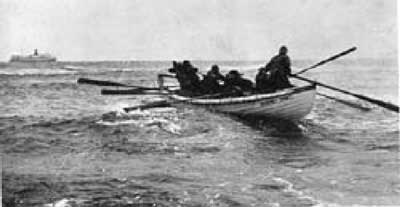Working Sail
When I was on active duty with the U. S. Coast Guard in the early 1960’s, we were still using the old wooden 26’ Monomoy “pulling boats” as the primary life boats aboard the large Cutter’s. They were also used for rescue and recovery work at sea. We spent a week training in the teamwork and proper use of these classic boats. I have a fond memory of these old work horses.

Monomoy Surfboats were designed for the high surf off Monomoy Island and Chatham, Massachusetts (Cape Cod).
“Made to both transit the most unimaginable waters that nature could conjure and to return through the same surf loaded with the storm's victims, these boats required a degree of skill unparalleled among mariners. Keen knowledge of the vagaries of breaking surf, instant, explosive power to take advantage of the interval between combers and relentless grit to continue rowing while beyond exhaustion were prerequisites to a crew even entering a surfboat.” -- Hull Lifesaving Museum
The Monomoys are 26’ long with a 7’ beam and draw of about 2‘ with the crew on board. Most weigh over 2,000 lbs. The rowing configuration is double-banked, that is, the eight rowers sit in four pairs side-by-side on fixed thwarts (benches). (In single-banked boats, like racing shells, rowers sit fore and aft of each other, each on their own seat.) Each rower handles a single 12’ wooden oar. The oars range in weight from 11 to 15 lbs. A coxswain stands in the stern and steers with a 16’ oar. In a BAWRA race, a 10th person rides in the bow for added safety.
“The Monomoy design is an evolution of the classic utilitarian whaleboat: a double-ended, lightweight, cheaply constructed boat to be rowed or sailed under all conditions in pursuit of whales and for use in general ship's work. In 1934 the U.S. Coast Guard standardized the design for contract purposes, and thousands were built for use as lifeboats and gigs aboard not only naval and military ships but also commercial freighters and ocean liners.....The boat is quite simple and Spartan.” -- From Wooden Boat Magazine, A Tale of Two Sisters: Carvel vs. Cold Molding, January/February, 1982 By W. Tay Vaughan, III
It was possible, and still popular in the early 20th Century, for commercial fishermen to modify and rig boats like these with a working sail in order to free up space for the catch.
A tough way to make a living for sure. Life is not always easy, but it needn’t be.
/fl
